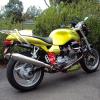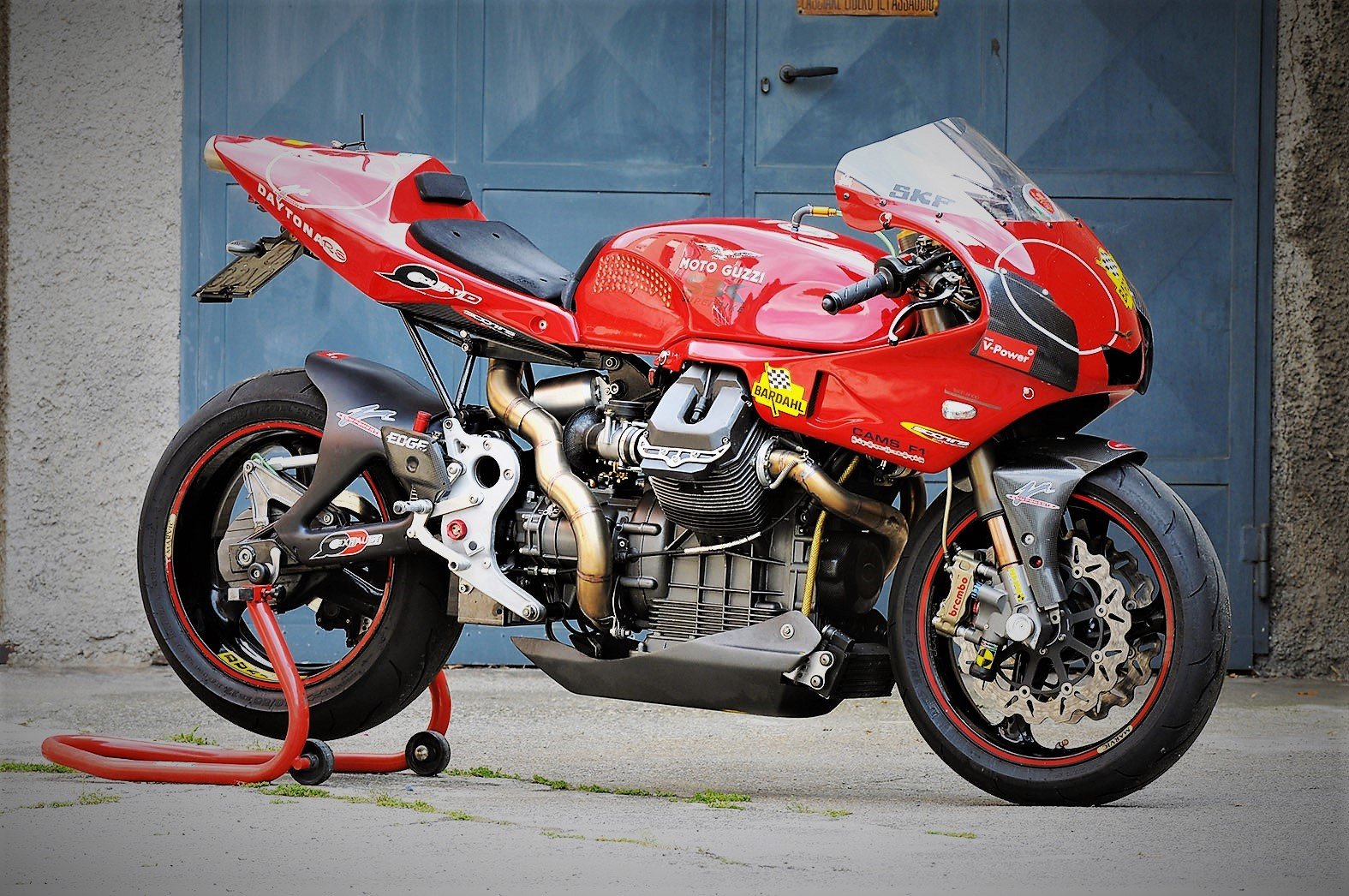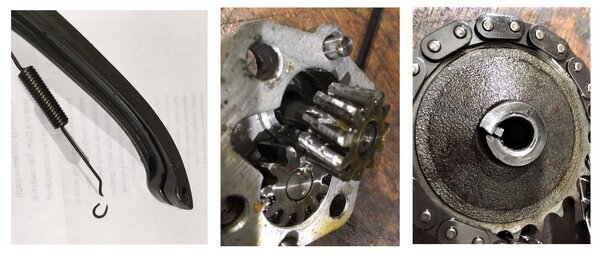-
Posts
4,538 -
Joined
-
Last visited
-
Days Won
234
Content Type
Profiles
Forums
Events
Gallery
Community Map
Everything posted by Lucky Phil
-
The intensity varies on mine, not that it means much really. The last thing I'm about to rely on with an Italian motorcycle that's 20 years old is the fuel warning light and the Neutral light. The trip meter is my guide. Then again I've twice rolled into petrol stations coughing on fumes. Which either supports my theory to the perfection of my range calculating or not, depending on your perspective. One thing I never do is let an Italian motorcycle warm up on the side stand with the neutral light illuminated. That's just too tempting for the Italian God of electrics. Ciao
-
Straight off a charger or immediately post shutdown an Odyssey will read well above 13 volts for a while until the surface charge dissipates but from memory 12.85 is fully charged after that. As a matter of fact 12.5 volts is only around 40% charged for an Odyssey. The figures are on their website. Ciao
-
Not surprised with 230 kg dry weight and 80 WHP on a 170/180 section rear tyre Ciao
-

Screenshot 2021-07-23 085537.png
Lucky Phil commented on Lucky Phil's gallery image in Members Gallery
-
From the album: lucky phils V11
-
From the album: lucky phils V11
-
When I rebuilt the Centy engine Chuck I had the option of the plastic or the brass temp sensor holder, I went with the brass. I can't remember which was the later version but read somewhere recently it was the plastic which wouldn't make sense to me as i would always go with the later updated part when I have a choice. Anyway part of my logic at the time I do remember was the plastic holder seemed to have the sensor bulb suspended in mid air within the holder which didn't seem like a good idea with regards to responsiveness so I went with the brass holder and also applied some high temp grease inside to surround the sensor bulb and transmit heat from the holder to the bulb more directly. Did it work? not sure as I have no comparative data but it runs nicely Ciao
-
The Cam chain is actually in a power transmission path, the path to transmit force or power if you like from the crank to the load, which in this case is the valve train. That load varies with rpm. The tension on the cam chain is related to the load it's being asked to transmit. More rpm requires more energy to drive the valve train so the load on the cam chain/drive is greater. Also F=ma so Force = mass x acceleration so the valve train and cam drive all have mass. The faster you accelerate that mass the more force is required and the cam drive needs to transmit. So it follows that the more rpm the engine is turning and the rate at which it gets there increases the load or force on the cam chain. At steady state throttle opening and engine load the force on the cam drive is constant. Ciao
-

ANSWERED Installed new battery, spins over but won’t start
Lucky Phil replied to Taxguy's topic in Technical Topics
Yep, it's a skill getting all those wires on the bolt including the battery tender wire and threaded onto the terminal. Imagine casting aspersions on Italian electrics! Ciao -

ANSWERED Installed new battery, spins over but won’t start
Lucky Phil replied to Taxguy's topic in Technical Topics
Or maybe, just maybe, you missed connecting one of the hot side battery wires. Like the one that powers the ECU through fuses F1 and 2. Ciao -
So do I, Aviation, but I trust my own engineering. I wouldn't do anything unless it was safe. Belt and braces for me. You know 20 years ago we needed a "special tool" to remove a component in the lube unit of the CFM-56 jet engines that powered the Boeing 737's in our fleet. We didn't have the tool and the lead time to get one was long and the Maintenance Manual showed a drawing and dimensions. So I requisitioned some material out of the stores system and took it home and machined/made a couple and took them to the tool crib for use doing the job. All worked perfectly for maybe 5 years then the Aviation world went totally compliance crazy. It was always quite strict but then it went totally full scale. My terrific and perfectly useful tools went in the bin. No official paperwork to certify their "compliance" sigh. Ciao
-
Yes I'm aware of the this and it's all largely correct, the valve spring returns SOME of its potential energy back to the camshaft after it's compressed but it's a matter or proportion. From memory it can only return around 80% or maybe less on average due to friction, and other dynamic losses such as having the task of reversing the valves acceleration and pulling the valve back onto its seat so the net result is still not a reversal it's only a lessening of torque in the same direction. There is no perpetual motion machine you don't get all the energy back at any point so the net result is always an input to a greater or lesser degree which keeps the force in one direction to a greater or lesser degree. A multi valve/cylinder engine with more lobes smooths this sine wave energy action as does greater rpm. If it was some sort of single cam lobe mechanism with little or no frictional losses and little work to do I might be convinced but for a typical engine running in typical circumstances I don't think so. I think I dispelled the theory of the cam drive and wear/play and inadequacies/wear/spring fatigue in the tensioner causing the hiccupping when I went to the gear driven cams. It made no difference at all I'm disappointed to say, it still hiccupped as before in the same particular circumstances. Ciao
-
All true. Didn't actually mean to sound like I have the definitive answer here it's a considered opinion only. Interestingly a lot of Einstein's theories were the result of what he called "thought experiments" as mankind didn't have the technology to prove his theories at that time. It's amazing how many are being proved correct now we have the technology to be able to run a physical experiment and measure the outcomes. The 2800-3200 rpm hiccup is the LP "thought experiment" Can't give an Einstein guarantee though. Ciao
-
Never cool, too much "look at me" going on there. Better the warm inner knowledge you are a man of quality, distinction and elegance and have no need to descend into tawdry displays of engineering opulence. The nod and a wink is all thats required. Ciao
-
Well docc you can deduct the cost of a new cam chain, sprockets and tensioner from the cost of the gears because it's probably about due for those. I learned about 25 years ago that values are relative after one of the guys at worked scoffed at the cost of my new motorcycle when he heard what I'd paid for it, around $16,000 from memory. I remember thinking at the time, this guys passion was his 60' motor cruiser that cost about $150000 at the time to buy and $1000 to fill with fuel another $5000 a year for mooring fees and it got used about a dozen hours a year. Go figure values out. I sometimes look at my bikes and wonder what people in maybe 50 years time when I'm long gone think about the owner that made all these modifications? I always liked reading about old bikes from the early part of the last century that were uncovered with loads of enhancements from some long dead previous owner that loved the thing. A lasting legacy for others to wonder about one day maybe. Ciao
-
The stability is controlled by the shop stand and the front lift support by the scissor lifter. It's stable. You can of course have a simple small wooden frame to locate on the sump when you use the scissor lift if your worried. My large holder was made for an engine change where I lifted the chassis over the engine on the lift bench and for engine storage. An overkill in all other situations. Ciao
-
It doesn't quite work like that docc if I get your meaning here. Basically the tension on the cam chain doesn't vary between on and off throttle, the forces on it don't reverse. It's not in tension when on the gas and slack when off the gas. It's more a case of in tension on the gas and off the gas and more tension or load when accelerating due to increased valve train loads and friction. You're never in a situation where the cam chain loads are reversing, it's more or less load situation but always in the same direction under normal running conditions. In some ways the tensioners job is easier at higher rpm than at idle depending on the engine configuration. The reason for the throttle hick at steady state only is the same as the reason you don't always feel the dip in an engines torque curve you see on a dyno because you accelerate through the area fairly quickly. Same as areas where the jetting/mapping is slightly off, if it's in an area you accelerate through briefly then it doesn't get noticed or is of no operational consequence. So the reason for the 2800-3200 rpm hick up I think is in this area there is a combination of related factors that come together under certain circumstances with regards to mapping and environment and if you ask the engine to operate in that area in a steady state under the right conditions you will get the effects. Even under the right conditions if you dont hang around in that rpm/load area but just ride through it same as the torque curve dip it in effect becomes a quickly transitioned area as the engine accelerates that isn't felt. Combined that with the fact that when you accelerate through the area you are probably using a throttle opening that doesn't equate with the problem anyway. If I still had the 2 valver fitted I'd change the ignition advance in the area I pointed out earlier and then see the effect which might take a while for all the environmental stars to align. Ciao
-
Well I have the ability to learn but it's like playing a guitar like an expert it takes many many hours before it's like an extension of your body. I used to set up the Mill to do work I wanted and anything remotely involved I would get him to do as I didn't want to wreck an expensive part due to a lack of skills. it never helped my confidence when I watched a master like him work the X/Y manual feeds together smoothly and with finesse. I knew then that I probably don't have enough years left to ever become that good and it be second nature. Ciao
-
If you look at my how to post on installing the gears I used the metal gasket and did the front seal while I was there as you suggested. The most noticeable thing initially after installing the gears was the need to reduce the idle by 200 rpm as after the gear install it was idling high. Less friction and drag? maybe. Ciao
-
It didn't. I'd say the failed tensioner resulted in total loss of cam chain control which then caused the oil pump and drive gear failure. Ciao
-
Here's an interesting image of a 1 year old blade style tensioner failure. Nasty collateral. Ciao
-
This, race stands at the back and a scissor jack. The wooden part is a dedicated engine holder which isn't totally necessary. Ciao









